National Influenza Vaccination Week (NIVW) kicks off December 4. In our new series, “The Science Behind our Stories”, Vaccinate Your Family is taking you on a deep-dive into the science of flu vaccines, guided by advocates who have lost a loved one to flu.
Each day during National Influenza Vaccination Week, a new person will cover a different topic related to flu and flu vaccination on VYF’s social media – or you can read all the great information they have to share right here in one place! We’re covering…
- The history of flu vaccines – with Jenn Romero
- How do we know how well vaccines work? – with Serese Marotta
- Types of flu vaccines – with Dr. Jeb Teichman
- Strain selection – with Julie Moise
- When to get a flu vaccine – with Maurine Neiman
Learn more about the 2023-24 flu season and Vaccinate Your Family’s #NotJustFlu Campaign here.
The history of flu vaccines
Brought to you by Jenn Romero.
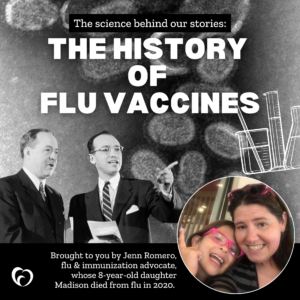 Hi, my name is Jenn & I advocate for flu vaccination because my 8-year-old daughter, Madison, died from flu in 2020. Read Madison’s story here. I’m joining Vaccinate Your Family this week to help share the science behind our stories – a deep dive into the science of flu vaccination. I’m excited to tell you more about the history of flu vaccines.
Hi, my name is Jenn & I advocate for flu vaccination because my 8-year-old daughter, Madison, died from flu in 2020. Read Madison’s story here. I’m joining Vaccinate Your Family this week to help share the science behind our stories – a deep dive into the science of flu vaccination. I’m excited to tell you more about the history of flu vaccines.
The history of immunization is a vast and unique one. Over centuries, humans have sought ways to protect themselves and each other from deadly diseases. As early as the 1100s, the variolation technique was developed and practiced in various forms in places like Turkey, Africa, China, and Europe. But for a long time, people thought flu was caused by a bacterium and early vaccines were not effective. Progress towards an effective vaccine only began in the 1930s when the influenza virus was identified.
In the 1940s, Thomas Francis, Jr., MD, and Jonas Salk, MD, at the University of Michigan worked to develop the first inactivated flu vaccine. At the time, there were no ethical standards, and the vaccines were tested on institutionalized individuals without their consent. The development of the vaccine was supported by the U.S. Army. They used fertilized chicken eggs, a method still used to make most flu vaccines available today. In 1945, a flu vaccine was licensed for civilian use.
In 1960, the CDC acknowledged the significance of educating medical professionals and the public about annual flu vaccinations. Fact sheets with technical terms in medical journals were sent to doctors’ offices. The U.S. Surgeon General advocated for annual vaccination of at-risk groups, such as people aged 65 years or older, and tasked the CDC with developing a plan to ensure those recommended for yearly vaccination would receive it.
Over time, scientists have continued to improve on flu vaccines in terms of their safety & effectiveness. In 2010, the CDC implemented a universal recommendation for annual flu vaccination for everyone 6 months and older.
How do we know how well vaccines work?
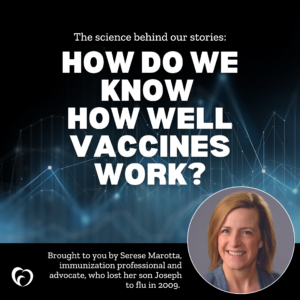 Brought to you by Serese Marotta.
Brought to you by Serese Marotta.
Hi, I’m Serese & I advocate for flu vaccination because I lost my healthy 5-year-old son Joseph to flu in 2009 during the H1N1 pandemic. Read Joseph’s story here. I work on immunization education and advocacy now, but before that my career focused on science . I’m going to explain vaccine effectiveness, or how we measure how well vaccines work.
We use a measurement called vaccine effectiveness (VE) to measure how well vaccines protect us against infection, illness, hospitalization, or death in the real world. Flu VE is measured by comparing how often vaccinated and unvaccinated people get flu or suffer from a severe flu-related outcome like hospitalization or death. There are different VE numbers for different age groups, different flu strains, and different outcomes.
Looking closer at the numbers: a 50% VE against illness means vaccinated people had half as many illnesses compared to unvaccinated people. This means that vaccinated people had a 50% lower risk of disease.
Flu vaccines have a different VE against infection, illness, hospitalization, and death – it might be 90% effective against death and only 40% effective against infection. That tells us that while a vaccine might not prevent you from getting sick, it can help prevent you from getting very sick or dying. Flu vaccines typically follow this pattern — they provide some protection against infection and better protection against serious illness, hospitalization, and death from flu.
VE can also vary depending on age and health history, and can be affected by how well flu vaccines are matched to circulating flu strains. Year-round, global surveillance is conducted to select the four flu strains that are included in flu vaccines each season. Because we have different formulations of seasonal flu vaccines each year (to protect against circulating strains) we see different VEs each year, too. Scientists track these numbers closely to understand how well the vaccine works and how we can keep improving.
Types of flu vaccines
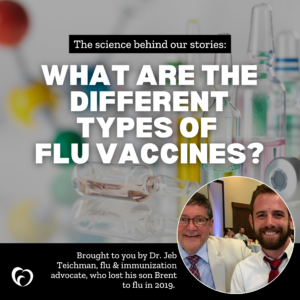 Brought to you by Dr. Jeb Teichman.
Brought to you by Dr. Jeb Teichman.
Hi, I am Dr. Jeb Teichman and I advocate for flu vaccination (and vaccination in general) in honor of my 29-year-old son Brent who lost his life to flu in 2019. Read Brent’s story here.
This week I’m partnering with Vaccinate Your Family to help share the science behind our stories – a deep dive into the science of flu vaccination.
Because flu vaccines have been around for decades, scientists have developed different types of flu vaccines. These vaccines vary based on how they are made and how they work, but all flu vaccines go through clinical trials and are tested extensively to make sure they are safe and work well. All available flu vaccines help protect against the same four seasonal flu strains – referred to as quadrivalent.
The most common flu shots are egg-based inactivated quadrivalent vaccines. This means that they are produced by growing flu viruses in chicken eggs, and then purifying the virus antigens and inactivating them so they are not dangerous to people. It is safe for people with an egg allergy to receive egg-based flu vaccines.
Nasal spray vaccines can be a good option for people who avoid flu vaccination due to a fear of needles. This vaccine is approved for ages 2 – 49 years in the U.S. It is a “live attenuated” vaccine, which means it contains weakened virus that cannot replicate or get you sick – just enough to activate your immune system to create antibodies. This vaccine is made in eggs like common flu shots.
In cell-based vaccines, flu viruses are grown in animal (specifically mammalian) cells rather than fertilized chicken eggs (no animals are harmed in this process). Recombinant vaccines are made using insect cells. A piece of protein from the flu virus is combined with portions of a virus that grows well in insect cells, and then this recombinant vaccine virus is allowed to replicate in insect cells before being isolated and purified. No eggs are used in the manufacturing process for recombinant flu vaccines.
Did you know that adults over 65 are recommended to get one of three specific flu vaccines that offer stronger protection? Adjuvanted flu vaccines have an additional ingredient (an adjuvant) to create a stronger immune response. High-dose flu vaccines have more of the antigen in them to create a stronger immune response. Recombinant flu vaccines are also included in the recommendation for this age group.
Though they aren’t available yet, mRNA flu vaccine options and combination COVID & flu vaccine options are currently in development. In the future you may even be able to give yourself a flu vaccine at home!
Peering into the crystal ball – strain selection!
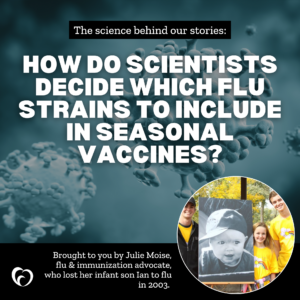 Brought to you by Julie Moise.
Brought to you by Julie Moise.
Hi, my name is Julie & I advocate for flu vaccination in honor of my son Ian, who we lost to flu in 2003. Read Ian’s story here. I’m joining Vaccinate Your Family and other advocates this week to help share the science behind our stories – a deep dive into the science of flu vaccination. Today I’m excited to tell you more about how the strains that flu vaccines protect against are selected.
Every year, the CDC recommends that everyone aged 6 months and older receive a flu vaccine. But before that, scientists select WHICH strains are included in this year’s vaccines. Have you ever wondered how scientists peer into the future to make the best guess at which flu strains will circulate?
This year’s flu vaccines are quadrivalent, which means they protect against four flu strains:
- Flu A(H1N1) virus
- Flu A(H3N2) virus
- Flu B/Yamagata lineage virus
- Flu B/Victoria lineage virus
The vaccine components for each are selected based on:
- which viruses are making people sick,
- how much the viruses are spreading,
- how well the previous season’s vaccines protect against those viruses, and
- the ability of the vaccine viruses to provide “cross-protection” (the ability to prevent infection from closely related flu viruses).
Each year, the flu viruses included in seasonal flu vaccines are selected based on a diversity of data:
Surveillance data – Globally, there are over 100 influenza monitoring centers that collect virus samples from patients year-round! Experts use this surveillance information to determine which flu strains are present and where the strains are circulating.
Laboratory data – Antigens are located on the surface of the flu virus and trigger an immune response when recognized by our immune system. “Antigenic characterization” in the laboratory means conducting tests to determine if current flu vaccines are capable of providing protection or if they need to be updated.
Genetic data – Flu viruses go through genetic changes over time. “Genetic characterization” monitors how flu viruses are changing and experts use this information to determine if vaccines will work against circulating flu viruses.
Clinical studies – Studies looking at vaccine effectiveness evaluate how well flu vaccines are working to protect against flu-related infection, illness, hospitalization, and death in a real-world setting.
It’s not too late to get a flu vaccine
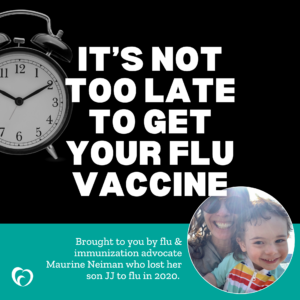 Hi, I’m Maurine & I have been an advocate for flu vaccination since I lost my 2 year old son JJ to flu in 2020. Read JJ’s story here.
Hi, I’m Maurine & I have been an advocate for flu vaccination since I lost my 2 year old son JJ to flu in 2020. Read JJ’s story here.
I’m joining Vaccinate Your Family today during National Influenza Vaccination Week with a simple reminder: it is NOT too late to get your flu vaccine if you haven’t already.
Getting a flu vaccine helps protect you against flu, but it also helps protect everyone around you. The more of us get vaccinated, the less flu can circulate in our communities. My son JJ had been vaccinated against flu, but that protection would have been stronger and JJ might still be alive if everyone around us had also been vaccinated.
So when should you get your flu vaccine? Flu vaccines are recommended for as long as flu is spreading in your community. The best time to get it is BEFORE it starts spreading, but even if flu is already around it isn’t too late to benefit from the protection vaccines offer.
Typically, experts recommend getting vaccinated before the end of October. BUT if you haven’t gotten vaccinated yet it is not too late.
Flu activity (the spread of flu) usually peaks in the Northern Hemisphere in January or February. The winter holidays, when we gather indoors with family and friends, can unfortunately spread germs and viruses including flu. So get vaccinated now if you haven’t already to make sure you’re protected before gathering!
In loving memory of Madison, Joseph, Brent, Ian, JJ and all those we have lost to flu.
Vaccinate Your Family thanks Jenn, Serese, Jeb, Julie, and Maurine for their continued efforts to raise awareness for the importance of flu vaccination. We hope The Science Behind our Stories taught you something new about flu vaccines and how they work. If you haven’t gotten your seasonal flu vaccine yet, now is a great time to get it before the winter holidays. It’s not too late!


